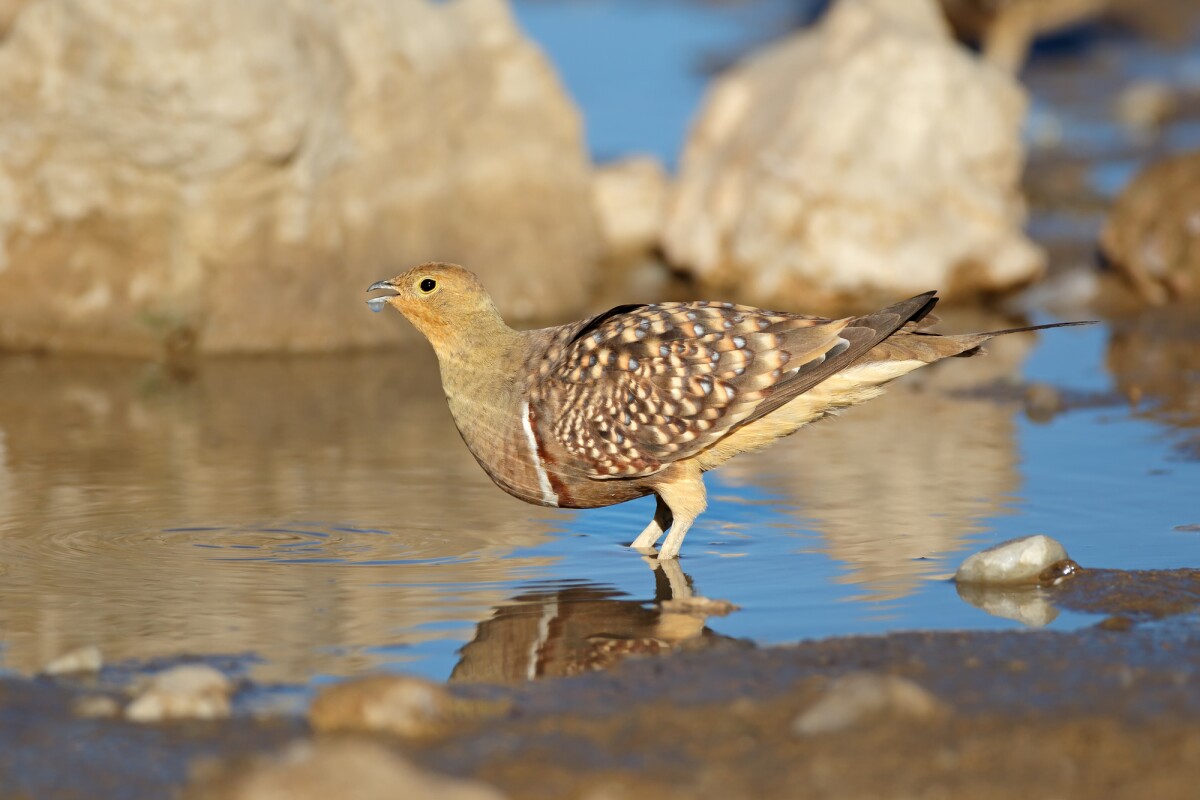
This is so odd. It works to both absorb water, but to also prevent a reversal of the process. No other bird does this and replicating this can be handy. Now imagine a water permiable membrane feeding an underlying layer. Handy in arid conditions for preserving water from your sweat.
Early days and somewhere we will have a perfect applicatrion for this. At least we know it is possible and plausible.
All good
Water-absorbing feathers could inspire better bottles and fog harvesters
By Paul McClure
April 12, 2023
https://newatlas.com/biology/first-view-birds-unique-water-holding-feathers/?
Scientists have taken a microscopic look at the belly feathers of the male desert sandgrouse, the only bird whose feathers can absorb and hold water
The male desert sandgrouse might not be much to look at, but his belly feathers give him the unique ability to absorb and carry water. Researchers have, for the first time, closely examined the structure of the feathers to see how they absorb water and whether the process might be adapted for human use.
When you think of feathers, you probably think of their ability to repel water. Not so the belly feathers of the male desert sandgrouse. He can visit a watering hole, absorb water into his feathers, fly more than 12 mi (20 km) across the desert, and still have enough water left over to satisfy a nest full of squawking chicks. It’s an amazing feat when you consider he can hold about 15% of his body weight in water while flying at speeds of around 40 mph (64 kph).
The sandgrouse’s water-carrying abilities were first noticed in 1896 by Edmund Meade-Waldo, an ornithologist and conservationist, while he was breeding the birds in captivity. Sadly, when he reported his findings to others, nobody believed him. It wasn’t until 1967, when Tom Cade and Gordon MacLean reported their observations of sandgrouses at watering holes in the journal The Condor, that the scientific world took notice.
Now, researchers from Johns Hopkins University and MIT have used modern high-resolution microscopes and 3D technology to get a never-before-seen look at what gives these feathers their water-holding ability. They used belly feathers from a male adult Namaqua sandgrouse, common to Namibia, Botswana and South Africa.
Using a scanning electron microscope, microcomputed tomography, light microscopy and 3D videography, the researchers were able to look at the shafts of the belly feathers, which are a fraction of the width of a human hair, and the even smaller barbules. These tiny hooks provide mechanical structure and aerodynamic integrity.

Scanning electron micrograph of the inner zone of a dry Namaqua sandgrouse belly feather showing the barb shaft, the helical coils of the barbules adjacent to the barb shaft and the straight, fibrous extension of the barbules beyond the helical coils
Johns Hopkins University
They then undertook the delicate task of dipping the dry feathers in and out of water and, under great magnification, watched as the feather’s structures absorbed the liquid.
“When you do that type of work, you can’t even breathe or else you blow it away,” said Jochen Mueller, co-author of the study.
Generally, bird feathers have a central shaft with smaller barbs coming off it and even smaller barbules coming off those. But in dry sandgrouse feathers, the inner zone of the feather has barbules that are helically coiled at their base that then straighten out. In the outer zone, the barbules are straight and much longer, arranged in fringes.
The researchers found that in the wet feathers, the barbules in the inner zone were small and flexible so that surface tension is enough to bend the straight parts into tear-shaped structures that hold water. The outer zone barbs and barbules curled around the structures of the inner zone, helping to keep the water in place. On drying, the structures reverted to their original form.
“It’s super fascinating to see how nature managed to create structures so perfectly efficient to take in and hold water,” Mueller said. “From an engineering perspective, we think the findings could lead to new bio-inspired creations.”
While it was previously thought that surface tension enabled the feathers to retain water, this study demonstrates that it is the flexibility of various parts of the feather that is key.
The study’s findings could lead to useful human applications, say the researchers. For example, in desert regions such as the Atacama Desert in Chile, where water is scarce, but fog and dew regularly occur, an adaptation of the feather structure could be incorporated into water-collecting nets.
“You could imagine this could be a way to improve those systems,” said Lorna Gibson, co-author of the study. “A material with this kind of structure might be more effective at fog harvesting and holding the water.”
Another potential use would be in the design of a water bottle that holds a lot of liquid but relies on the feather structure to keep the water from moving about when someone is, say, jogging.
“That’s what excited us, to see that level of detail,” Mueller said. “This is what we need to understand in order to use those principles to create new materials.”
The researchers intend to 3D print similar structures, pursuing commercial applications for their discovery.
The study was published in the Journal of the Royal Society Interface, and the below video, produced by Johns Hopkins University, shows how the scientists conducted their research and includes some of the images they collected.
How an African Bird Might Inspire a Better Water Bottle
No comments:
Post a Comment